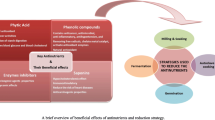Abstract
The effects of germination, extraction (double extraction with 70% ethanol and water at isoelectric point) and α-amylase treatments of chick pea seed flours on crude protein, total carbohydrate, protein efficiency ratio (PER), biological value (BV), true digestibility (TD), net protein utilization (NPU), essential amino acid composition, in-vitro protein digestibility (IVPD) and actual amino acid indices (essential amino acid index or amino acid score) were evaluated. Crude protein content was increased (8–149%), while total carbohydrate was decreased (11–62%) by germination, extraction and α-amylase treatments. Alpha-amylase treatment was more efficient in reducing total carbohydrate and increasing the protein content than that of extraction treatment. The protein quality of chick pea flours as measured by PER, BV, TD, NPU, IVPD and corrected amino acid indices (actual amino acid indices×IVPD) was significantly improved by these treatments. The protein quality of germinated-α-amylase treatment was comparble with casein, while germinated-α-amylase treaded seeds appeared nutritionally superior to casein. The results indicate that the germinated-α-amylase and germinated-α-amylase-extracted treatments could be used successfully as a source of concentrated high quality protein for baby food production. The corrected amino acid indices gave better prediction of PER, BV, TD and NPU (r=93 to 97) than actual amino acid indices (r=45 to 71). PER was highly correlated with corrected amino acid score (r=0.93). The PER could be predicted from the following simple regression equation: PER=−1.827+0.0561×corrected amino acid score.
Similar content being viewed by others
References
Singh U, Subrahmanyam N, Kumar J (1991) Cooking quality and nutritional attributes of some newly developed cultivars of chick pea (Cicer arietinum). J Sci Food Agric 55: 37–46.
Duhan A, Chauhan BM, Punia D, Kapoor AC (1989) Phytic acid content of chick pea (Cicer arietinum) and black gram (Vigna mungo): Varietal differences and effect of domestic processing and cooking methods. J Sci Food Agric 49: 449–455.
Mansour EH, Khalil AH (1995) Nutritional changes during the fermentation of chick pea (Cicer arietinum) flour. Menofiya J Agric Res 20: 151–164.
Singh U, Jambunathan R (1981) Studies on desi and kabuli chick pea (Cicer arietinum) cultivars: Levels of protease inhibitors, levels of polyphenolic compounds and in vitro protein digestibility. J Food Sci 46: 1364–1367.
Mansour EH, El-Adawy TA (1994) Nutritional potential and functional properties of heat-treated and germinated fenugreek seeds. Lebensm-Wiss-Technol 27: 568–572.
Marero LM, Payumo EM, Aguinaldo AR, Homma S (1988) Nutritional characteristics of weaning foods prepared from germinated cereals and legumes. J Food Sci 53: 1399–1402.
Jood S, Mehta U, Singh R, Bhat CM (1985) Effect of processing on flatus producing factors in legumes. J Agric Food Chem 33: 268–274.
Nnanna IA, Phillips RD (1990) Protein and starch digestibility and flatulence potential of germinated cowpeas (Vigna unguiculata). J Food Sci 55: 151–153.
Mostafa MM, Rahma EH, Rady AH (1987) Chemical and nutritional changes in soybean during germination. Food Chem 23: 257–263.
AOAC (1990) Official methods of analysis, 15th edn. Washington, DC: Association of Official Analysis Chemists.
Moore S, Stein WH (1963) Chromatographic determination of amino acids by the use of automatic recording equipment. In: Colowick, SP, Kaplan NO (eds), Methods in enzymology Vol 6. New York: Academic Press.
Miller EL (1967) Determination of the tryptophan content in feeding stuffs with particular reference to cereals. J Sci Food Agric 18: 381–386.
Salgó A, Granzler K, Jecsai J (1984) Simple enzymic methods for prediction of plant protein digestibility. In Lásztity R, Hidvégi M (eds), Proc Int Assoc Cereal Chem Symp Budapest: Akadémiai Kiadó.
Oser BL (1951) Methods for integrating essential amino acid content in the nutritional evaluation of protein. J Am Diet Assoc 27: 396–402.
FAO/WHO (1973) Energy and protein requirements. Report of FAO Nutritional Meeting Series No. 52. Rome: FAO.
Eggum BO (1973) A study of certain factors influencing protein utilization in rats and pigs. Copenhagen: National Institute of Animal Science, Report No. 406.
Pellet PL, Young VR (1980) Some rat and human bioassay procedures. In Pellett PL, Young VR (eds), Nutritional evaluation of protein foods. Tokyo: The United Nations University.
SAS (1985) SAS users guide: Basics version, 5th edn. Cary, NC: SAS Institute.
Khalil AH, Mansour EH (1995) The effect of cooking, autoclaving and germination on the nutritional quality of faba beans. Food Chem 54: 177–182.
Khan MA, Jacobsen I, Eggum BO (1979) Nutritive value of some improved varieties of legumes. J Sci Food Agric 30: 395–400.
Rowayshed GH, Shahat MS (1994) Biological evaluation of sunflower and soy protein products. Menofiya J Agric Res 19: 3207–3221.
Mansour EH (1993) Chemical, functional, nutritional properties and food applications of pumpkin seed and rapeseed protein products. Ph.D. Thesis. Budapest: National Institute of Food Hygiene and Nutrition.
Mansour EH, Dworschák E, Lugasi A, Barna É, Gergely A (1993) Nutritive value of pumpkin (Cucurbita pepo, kakai 35) seed products. J Sci Food Agric 61: 73–78.
FAO/WHO/UNU (1985) Energy and protein requirements. Report of a Joint FAO/WHO/UNU Meeting Series No. 724. Geneva: WHO.
Sathe TB, Deshpands SS, Salunkhe DK (1982) Functional properties of lupin seed (Lupinus mutabilis) proteins and protein concentrates. J Food Sci 47: 492–497.
Wolzak A, Elías LG, Bressani R (1981) Protein quality of vegetable proteins as determined by traditional biological methods and rapid chemical assay. J Agric Food Chem 29: 1063–1068.
Author information
Authors and Affiliations
Rights and permissions
About this article
Cite this article
Mansour, E.H. Biological and chemical evaluation of chick pea seed proteins as affected by germination, extraction and α-amylase treatment. Plant Food Hum Nutr 49, 271–282 (1996). https://doi.org/10.1007/BF01091976
Received:
Accepted:
Issue Date:
DOI: https://doi.org/10.1007/BF01091976




